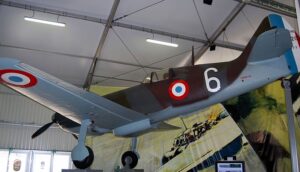Time Period: World War I
Country of Origin: United Kingdom
Type: Biplane, Fighter Aircraft, Reconnaissance and Surveillance
Manufacturer: Vickers Limited

Vickers F.B.14 Aircraft Overview
The Vickers F.B.14 was a British single-seat biplane fighter aircraft designed and built by Vickers Limited during World War I. It was an improved version of the earlier Vickers F.B.5 fighter and was primarily used for reconnaissance and fighter duties.
The Vickers F.B.14 was a two-bay biplane with a wooden structure and fabric covering. It was powered by a 110-horsepower Le Rhone rotary engine and had a top speed of around 102 miles per hour (164 kilometers per hour) and a ceiling of around 16,000 feet (4,900 meters). The aircraft was armed with a single synchronized Vickers machine gun mounted on the fuselage.
The F.B.14 was an improved version of the earlier F.B.5, with a larger and more powerful engine, a redesigned tailplane, and other refinements. It was well-regarded by pilots for its good maneuverability and handling, and was also relatively stable in flight.
In addition to its reconnaissance duties, the Vickers F.B.14 was also used as a fighter aircraft, and was flown by a number of British aces, including James McCudden and Edward “Mick” Mannock. It was also used by a number of other air forces during and after World War I, including the Royal Navy and the Australian Flying Corps.
Overall, the Vickers F.B.14 was an important fighter and reconnaissance aircraft of World War I, and helped establish the importance of reliable, easy-to-handle aircraft designs in the early years of aviation.
Vickers F.B.14 Specifications
- Crew: 2
- Length: 28 ft 5 in (8.66 m)
- Upper wingspan: 39 ft 6 in (12.04 m)
- Lower wingspan: 33 ft 0 in (10.06 m)
- Height: 10 ft 0 in (3.05 m)
- Wing area: 427 sq ft (39.7 m2)
- Empty weight: 1,662 lb (754 kg)
- Gross weight: 2,603 lb (1,181 kg)
- Powerplant: 1 × Beardmore 160 hp water-cooled straight-six engine.
Vickers F.B.14 Performance
- Maximum speed: 99.5 mph (160.1 km/h, 86.5 kn) at sea level
- Endurance: 3 hr 45 min
- Service ceiling: 10,000 ft (3,000 m) ; Absolute ceiling 10,600 ft (3,200 m)
- Time to altitude: 40 min 45 s to 10,000 ft (3,000 m).
Vickers F.B.14 Armament
- Guns:
- 1 × forward-firing .303 in (7.7 mm) Vickers machine gun
- 1 × .303 in (7.7 mm) Lewis Gun fitted on a Scarff ring in the rear cockpit.
Vickers F.B.14 Image Gallery
More Vickers Aircraft

Vickers Boxkite
The Vickers Boxkite was a British experimental monoplane aircraft used in the flying school at Brooklands. They had a 50 hp Gnome engine.

Vickers Wellington
The Vickers Wellington was a British twin-engined, long-range bomber designed during the mid-1930s at Brooklands in Weybridge, Surrey.

Vickers F.B.19
The Vickers F.B.19 was a British single-seat fighting aircraft used during World War I. It was also sometimes called the Vickers Bullet.

Vickers Vimy
The Vickers Vimy was a British heavy bomber manufactured by Vickers Limited and used during the latter stages of the First World War.

Vickers F.B.12
The Vickers F.B.12 was a British biplane pusher fighter aircraft developed by Vickers Limited and used during World War I.









